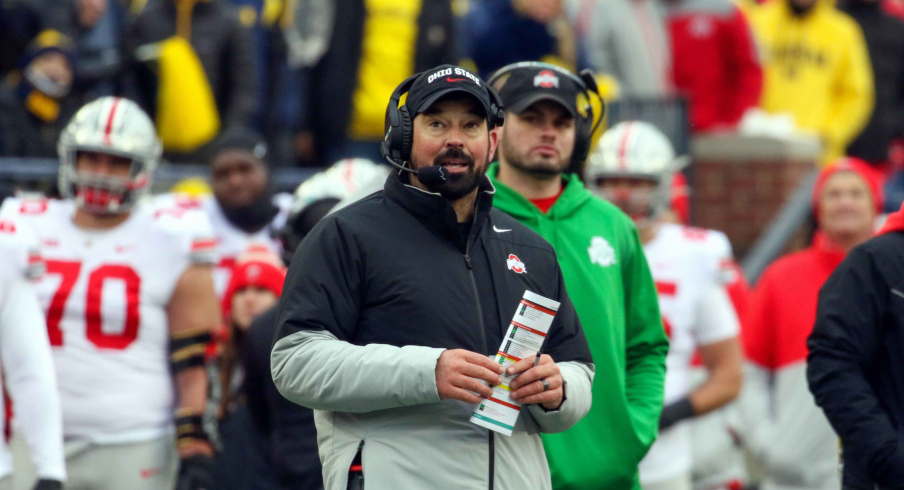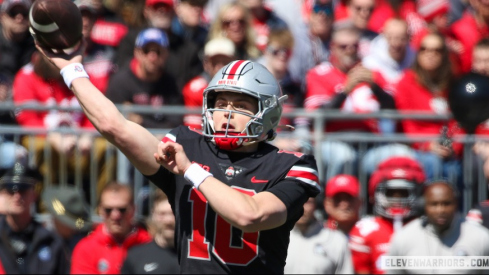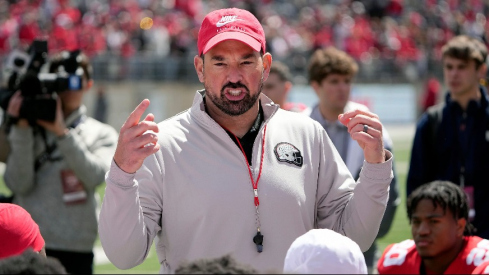It's been a very astrange autumn for the folks up north.
September provided a period of cautious optimism, with various members of the coaching staff absent from the sideline as the maize and blue beat on various opponents from the lowest rungs of the FBS. For a few weeks in October, that optimism turned to confidence, as dominant wins over conference competition had many writing 'Michigan' into their playoff brackets with magic marker. But we all know what came next.
While the Wolverines have yet to lose a game since we all learned the name Connor Stalions, they've looked like a very different team. Some of that can be the shutdown of Stalions' sign-stealing operation, but the suspension of Jim Harbaugh, the firing of linebackers coach Chris Partridge, and the ever-looming distraction of more allegations coming to light have all clearly factored into some sub-par performances over the past two weeks.
Throughout it all, what Michigan has tried to do on the field has devolved in striking fashion, with quarterback J.J. McCarthy having the ball effectively taken out of his hands and put back in those of Blake Corum. Luckily for America's Team (supposedly), the defense has been able to rely on the kind of interior line normally found in Athens or Tuscaloosa.
For Ohio State to knock off their arch-rival for the first time since 2019, they must avoid getting sucked into the kind of rock fight that both teams waged against Penn State. Though the Buckeyes proved capable of winning tough, hard-fought games against talented teams like Notre Dame and the Nittany Lions, the Wolverines still provide an even greater challenge than both.
Doing so will require Ryan Day and his staff to play the kind of complementary football he has preached throughout this season. All three phases of the game plan must work together, as the Buckeyes simply cannot allow another first-half lead to disappear as it has each of the past two years.
As has long been the case in The Game, however, that's easier said than done. Though many of the storylines around this game revolve around who isn't on the sidelines, it's worth noting that schematically, the Wolverines remain quite similar to last year's iteration.
The biggest difference from an Xs and Os standpoint is the evolution of Jim Knowles' defense, which is far less aggressive than a year ago. Rather than give up the big play while trying to create one of their own, the Buckeyes have been one of the nation's best at keeping opponents from breaking a big one.
Here's what to expect in all three phases:
When Michigan Has the Ball
Despite throwing the ball 30+ times a game early in the season, offensive coordinator Sherrone Moore seems more than happy to bring in an extra offensive lineman (or two) and hand it off to Corum during the past two games. Such an approach plays to the strengths of the Michigan roster, as there are few groups in the sport featuring as much depth as there is in the offensive line room at Schembechler Hall.
Harbaugh and his staff have been effusive in their praise of the unit that is the two-time defending winner of the Joe Moore Award, touting the pro prospects of seven players capable of making NFL rosters all the way back in July. It should be no surprise, then, that in the program's biggest game to date this season, Michigan relied heavily on jumbo personnel packages that lined up all seven at once.
From those looks, the Wolverines relied heavily on gap scheme runs such as Power (their favorite concept) and numerous variations on the Counter concept. Like his brother's team in Baltimore (and unlike most at both the college and pro levels today), Harbaugh's offense utilizes the two-back version of Power, incorporating a fullback as a lead blocker to kick out an end before a pulling guard leads the runner through the C-gap. This creates two additional gaps that must be defended along the play-side, stressing the defense.
Buckeye linebacker Cody Simon, who played a whale of a game in relief of the injured Tommy Eichenberg last Saturday, noted this week that the OSU defense is prepared for such looks after seeing seven-man surfaces from Minnesota. After years of looking lost while defending so many run gaps at once in previous seasons, the growth shown under Jim Knowles' guidance shouldn't be discounted.
But, once again, this week's opponent provides a unique challenge in that the Gophers employed such looks from normal, two-tight end personnel, while the Wolverines do so from jumbo packages that force defensive backs to take on the blocks of 300 lb linemen. Though these personnel groups largely take away the threat of the pass, they almost always result in three or four-yard gains that keep the Michigan offense ahead of schedule and on the field.
Much as the Philadelphia Eagles believe they start every series with 'First & 9,' thanks to their efficiency at executing the 'Brotherly Shove' QB sneak in short-yardage situations, the Wolverines have been brutally efficient in such scenarios themselves. Michigan has converted 60% of 3rd and short (1-3 yds) situations on the ground this fall, and is even better when running on fourth downs, converting 6 of 9 such attempts.
But the flip side to that efficiency is a lack of explosive plays on the ground. Despite returning so many veterans on the offensive line, a preseason Heisman contender in Corum, and a backup in Donovan Edwards who has a reputation for making the big play, Michigan ranks just 86th nationally in runs of 10+ yards this season, and averages just 3.9 yards-per-carry in the month of November.
Much of this has to do with the new-found predictability in Michigan's offensive play-calling. With a 2-to-1 run-to-pass ratio in the two games since Harbaugh's most recent suspension began, opposing defenses have been calling for more and more run blitzes on early downs in an attempt to get the Wolverines off schedule.
Similar to the manner in which Knowles blitzed his safeties through the B and C-gaps against Rutgers and its run-heavy offense three weeks ago, Maryland found success sending a second-level defender on a delayed rush through the same gaps against Michigan.
While some have posited that the reason Michigan has leaned so heavily on the run game in recent weeks is due to a lack of trust in McCarthy, the real reason is likely a mistrust in that vaunted O-line to protect him. The strength of the unit may lie along the interior, but the tackles have proven to be liabilities in pass protection.
Injuries have created a revolving door on the left side while right tackle Karsen Barnhart (#52) has been exposed by speed rushers from Penn State and Maryland. After playing the best game of his Ohio State career last weekend against Minnesota, left end Jack Sawyer will surely be excited for his chance to take on a tackle whose confidence is assuredly shaken.
But McCarthy also hasn't looked like himself physically in the past few weeks, and rumors persist that he is battling some kind of knee injury. That in itself is a major factor for the Michigan passing game, as the junior's mobility is his most dangerous asset in the passing game.
He's been one of the rare college quarterbacks whose efficiency goes down the closer a throw is to the line of scrimmage, in large part because he can extend a play outside the pocket and identify receivers in a scramble drill as the coverage breaks down. That elusiveness often negated any pressure given up by his tackles over the past two years, as he possessed the wheels to escape the pocket and still make something happen. With a bad knee, however, that threat has clearly been diminished.
Additionally, his top receiver, Roman Wilson, exited the Maryland game with an injury, and although he should be back this weekend, is likely not at 100% either. But the Wolverine wideouts haven't been McCarthy's most dangerous targets throughout much of this season, anyway.
Where Michigan has done the most damage has been on check-downs underneath those receivers stretching the field vertically.
Very often, the Wolverines will call for deep, play-action passes once the defense commits too hard to the run. Big Ten secondaries have proven capable of running with Wilson or Cornelius Johnson on the deep routes, but the underneath defenders that were so hellbent on stopping the run have trouble getting back in coverage, allowing their talented tight ends or running backs to release underneath with plenty of room to run after the catch.
The Buckeyes must strike the balance between respecting McCarthy's ability to extend plays and keeping him contained while knowing when to let loose and go for the sack. Similarly, the back seven must also respect the run without selling out against it.
The decision of when and how to match personnel with the Wolverines may be the biggest X-factor in this game from Jim Knowles' perspective. Jordan Hancock has emerged as one of the defense's best and most versatile players, so does he stay on the field instead of a traditional cornerback against those jumbo sets? How often does Simon see the field as a third linebacker?
Ultimately, the Wolverines' M.O. all season has been to play their game and let opponents make the mistakes, pouncing on the rare opportunities and taking full advantage of a missed assignment or costly penalty. When the OSU defense is on the field, they simply can't afford to make any such errors, even if it means giving up an extra yard or two.
When Ohio State Has the Ball
Many have posited that Stalions' sign-stealing operation provided far more benefit to the Michigan defense than on the other side of the ball. Based on how that unit has played in the past few weeks, you wouldn't know they've lost their 'secret weapon.'
The Wolverines lead the nation in allowing the fewest yards-per-game (though the Buckeyes lead in yards-per-play allowed), and have surrendered the fewest points of any team in FBS this season. While things may have taken a turn on the offensive side of the ball in recent weeks, the Michigan defense only appears to be playing better at the most important point in the season.
Simply put, the Wolverines are incredibly consistent and fundamentally sound on defense, and often force opponents into making critical, game-changing errors that tip the scale in Michigan's favor.
Also like its offense, the strength of Michigan's defense lies along the interior of the line, with three defensive tackles all capable of wrecking a play on their own. Senior Kris Jenkins (#94) garnered much of the preseason attention ranking 6th on Bruce Feldman's annual Freaks list. But alongside the son of a former all-pro, sophomore tackles Mason Graham (#55) and Kenneth Grant (#78) have emerged as play-makers in their own right after Jenkins battled a nagging injury.
Grant, in particular, seemed nearly unblockable for large stretches of the Penn State game thanks to surprising athleticism for a 340-pounder.
The Buckeyes, meanwhile, have struggled at times to execute double-teams in the run game, either allowing defensive linemen to penetrate or leaving linebackers unblocked as two blockers were forced to stay on the lineman. As the season has progressed and a healthy TreVeyon Henderson returned from injury, Day and his staff have made a clear effort to move those second-level defenders from the box instead of simply hoping to block them.
In last year's game, in which Henderson was absent due to injury, the Buckeyes employed similar tactics, spreading out the Michigan defense from sideline to sideline. Although the Wolverines may have had the advantage inside, the edge players were put in conflict by the threat of a screen to the talented OSU receivers, as the safeties often sat back in a two-high shell.
Coordinator Jesse Minter isn't the most aggressive of play-callers, selectively dialing up blitzes with nickelback Mike Sainristil often coming off the edge in a fire zone scheme usually meant to stop the run. Instead, the Wolverines' most common path to success comes from stuffing the run on early downs before employing a variety of coverages meant to confuse opposing quarterbacks long enough to force a mistake when forced to drop back and pass.
The Wolverines rank third nationally in turnover margin thanks, in large part, to 19 takeaways. Those turnovers aren't the result of terrorizing edge rushers winning one-on-one matchups, as was the case in 2021, but rather come by way of self-inflicted wounds from the offense.
The matchup with Purdue in early November provides a great example. Already down multiple scores in the first half and unwilling to run the ball into the teeth of the Michigan front, the Boilermakers threw on 1st down.
Minter's call was a simple Cover 3 zone with match principles on the outside, though with a loop stunt between Jenkins and end Jaylen Harrell (#32) on the right side of the line. Despite the Purdue running back staying in to block and providing three blockers for the two rushers, the offense failed to pick up this simple stunt. This allowed Harrell a free rush to the QB and affected the throw, which ended up behind the receiver and intercepted.
This play was not an instance of schematic brilliance, nor was it an other-worldly play by any individual defender. Instead, it was sound, fundamental defense that was executed perfectly, while the opposition failed to do the same with something as simple as pass protection against a four-man rush.
This recipe isn't far different from the one that gave up 456 yards of offense to Ohio State one year ago, however. The Buckeyes had little trouble moving the ball between the 20s, it was only once they entered the red zone that the offense ground to a halt.
While many will point to the advantage gained by Stalions' sign-stealing, the Buckeyes only scored one touchdown during four trips inside the Michigan 20-yard line. There were, admittedly, some well-timed gambles from Minter that stymied C.J. Stroud and co. in these situations, but the Buckeyes seemed to get a little too cute once near the goal line.
After finding Emeka Egbuka on a crossing pattern for what would be their only red zone touchdown of the day to cap the opening drive, Day leaned on designed swing passes to Xavier Johnson, isolation routes to Cade Stover, or the use of heavy personnel that took Egbuka or Marvin Harrison Jr. off the field altogether.
Despite all the early-season bluster about the physicality of Ohio State's red zone approach, the Buckeyes have quietly recognized that their best weapon in such scenarios is the same one it is everywhere else: Harrison. The 6'4" wideout has used his big frame to catch 9 of his 13 touchdowns inside the red zone.
Rather than isolate him to one side and just throw jump balls his way, the Buckeyes instead have paired him with Egbuka (now healthy again) to run route combinations that minimize the defense's ability to double either player. If one is left in a one-on-one scenario, they're probably going to win, as Harrison did for his final touchdown in the Horseshoe last weekend.
Day showed in the victory over Penn State that he can scheme up ways to get his stars open, even when the defense knows to expect it. But Day was also without Henderson and Egbuka for that game, who both appear to be fully healthy ahead of the trip to Ann Arbor.
While Stover has been a reliable receiver capable of making plays of his own, he's clearly still hampered a bit by a knee injury of his own, limiting him to acting as a secondary option or safety valve.
The Plan to Win
Day must attempt to get out to a(nother) big lead, as he did in the first quarter of last year's game. The Buckeyes simply can't wait around and hope to organically involve its star wide receivers while Henderson gets beat up on inside run plays or get too cute with screen passes to Stover.
Given the familiarity between these two teams and the countless hours put in by both sides preparing for this game, there should be little time wasted trying to see how the Wolverines manage their coverage to account for two first-round receivers. Even if Kyle McCord isn't Good Kyle early in the game, they should keep the pedal down rather than play as tight as they did against Notre Dame.
With the growth and discipline shown by Ohio State's defense this season, Day should feel far more comfortable protecting any lead, at least compared to the past few years. But with McCarthy's injury, and a general lack of explosiveness all season long (the Wolverines rank 111th nationally in offensive plays of 30+ yards), the OSU head coach has reason to believe his defense can hold serve this time around.
Michigan wants nothing more than to turn this into another fistfight in a phone booth, allowing them to lean on their best players: the interior linemen on both sides of the ball. Just because Ohio State has proven it can win physical, low-scoring contests, it shouldn't be in a hurry to get into another one.
These two teams meet at a time when their trajectories are heading in opposite directions. Just as they did in 2018, the last time they were underdogs in this series, the Buckeyes should do everything in their power to force the opposition to play their game.
If Ryan Day still wants to prove a point to Lou Holtz, he should do it by winning this game his way.



